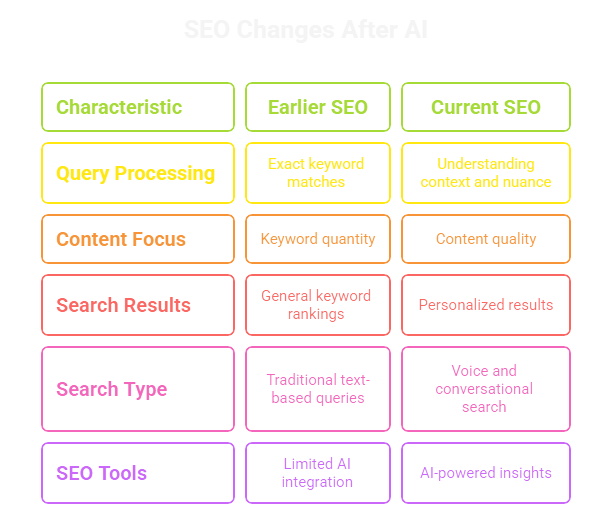
Table of Contents Book Intro Call Case Studies Share: Related Guides: Related Posts Step-by-Step Tutorial: How to Share Google Tag...
By: Admin, Sr. Content Writer / Published: July 7, 2025 / Last updated: July 7, 2025

Search Engine Optimization (SEO) was always a dynamic field, but the rise of Artificial Intelligence (AI) has accelerated changes at an unprecedented pace. What used to work even a couple of years ago—manual keyword stuffing, basic backlinking, and shallow content—is no longer enough. Today, search engines, especially Google, are powered by AI models that deeply understand user intent, content quality, and contextual relevance.
If you’re an SEO agency or marketer, adapting to this AI-driven landscape is not optional; it’s survival. Here’s what has changed and what you need to start doing right now.
AI models like Google’s RankBrain, BERT, and MUM enable search engines to process search queries the way humans do. It’s no longer about exact keyword matches but understanding the context, sentiment, and nuance behind a query.
Example:
Earlier: Ranking for “best Italian food near me” meant stuffing “Italian food near me” across your page.
Now: Google considers your restaurant’s menu, reviews, location, content tone, and even your site’s technical health to deliver a result that feels helpful to the user.
AI-powered algorithms analyze the depth, originality, and helpfulness of your content. Thin, regurgitated articles filled with keywords will no longer rank. Tools like ChatGPT and Jasper have made content creation easier, but Google’s Helpful Content Update has made it clear—AI-generated fluff won’t cut it unless it’s truly valuable to humans.
AI allows Google to customize results based on user behavior, location, and preferences. Two users searching the same keyword could see completely different results. Agencies now need to think beyond general keyword rankings and focus on audience intent segmentation.
With voice assistants like Alexa and Google Assistant, queries are becoming longer and more conversational. AI interprets these natural-language questions far better than before, making long-tail, question-based content critical for SEO.
AI has infiltrated SEO tools themselves—SurferSEO, Semrush, Ahrefs, Clearscope, and others now use machine learning to give data-backed content suggestions, competitor insights, and predictive analysis.

Use AI-powered tools to streamline your research, content outlines, and audits. But human creativity, strategy, and critical thinking must guide the process. Purely AI-generated content without human editing often lacks depth and nuance.
Do deep intent mapping. Why is someone searching “best CRM for startups”? Are they comparing options, looking for case studies, or ready to purchase? Create content for each stage of the user journey.
Move beyond keyword density and start optimizing for related terms, synonyms, and topics that give search engines a broader understanding of your content area. This approach is called semantic SEO.
AI crawlers assess page speed, mobile usability, structured data, and Core Web Vitals as part of the ranking process. Fix broken links, clean up crawl errors, and ensure your site architecture is clean and user-friendly.
Google’s Helpful Content Updates are clear: content made for search engines will be penalized. Your blogs, product pages, and landing pages should solve real problems for real people.
Google’s Search Generative Experience (SGE) and multimodal search (text + image + video queries) are the next frontiers. Agencies need to start creating multimedia content and optimize it cohesively.
AI didn’t kill SEO; it forced it to evolve. Agencies that adapt by blending AI-powered efficiency with human creativity and empathy will thrive. Those clinging to outdated tactics will fade away.
If your agency hasn’t yet redefined its SEO playbook for the AI era, the time to start was yesterday. But today works too—if you move fast enough.
Want to future-proof your SEO strategy? Let’s talk.

Table of Contents Book Intro Call Case Studies Share: Related Guides: Related Posts Step-by-Step Tutorial: How to Share Google Tag...

Table of Contents Book Intro Call Case Studies Share: Related Guides: Related Posts Step-by-Step Tutorial: How to Share Google Tag...

Table of Contents Book Intro Call Case Studies Share: Related Guides: Related Posts Step-by-Step Tutorial: How to Share Google Tag...
Our site uses cookies. By using this site, you agree to the Privacy Policy and Terms of Use.